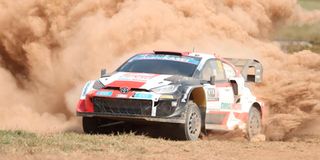Bankelele: WRC Safari Rally, done and dusted

Finland's Kalle Rovenpera navigated by Jonne Haltunnen racing on a Toyota Yaris in full cruise during Shakedown Loldia stage on June 22, 2022 during WRC safari rally Kenya.
The Safari Rally has just ended. Staged last week, Kenya's hosting of the 6th round of the World Rally Championship (WRC) series was expected to boost Sh6 billion to the economy according to President Uhuru Kenyatta who also mentioned that 78 million viewers from150 countries had watched the 2021 race.
The nature of the Safari Rally has changed over the decades, from endurance to sprints, and this year was another spectacle where we saw the drivers, via the WRC app and NTV, battle through dust clouds, punctures, mud, crashes, and car breakdowns. The rally now has different driver classes, so you have more winners such as for Class 2, Class 3, and the Kenya National Rally. Finland’s Kalle Rovanperä driving a Toyota GR Yaris was the overall winner after 19 stages, totalling 363 kilometres. Kenya's Maxine Wahome, who is in the FIA Rally Stars program that aims to nurture young drivers, was celebrated as the winner of the Rally 3 class.
From several comments online, while the Safari Rally 2021 was one of scarcity, the one of 2022 was one of abundance. An abundance of food, drink, supplies, music, and organisation.
While 2021 had caught people unaware resulting in excessive traffic and food shortages around the venue, this year had many enterprising vendors who stocked up on goods to sell at Naivasha. One supermarket chain was also an official sponsor of a race team and set up small mobile stores in strategic places. Many rally fans, having learnt from last year, were better organised in their planning and had stocked up on all the essentials they would need as they followed the cars around the different stages.
Kenya got the Safari Rally back after 20 years off the WRC calendar and has an agreement to host the Safari Rally till 2026. President Kenyatta has steered his government to deliver on its pledges in support of the rally, but next year there will be a new government with new priorities.
A few weeks, ago, Sports Cabinet Secretary Amina Mohammed said that in future years, the Safari could move to other counties. Three clusters were under consideration of Laikipia, Nyandarua, Meru and Nyeri or Kwale, Mombasa, Kilifi and Taita Taveta or Nairobi, Kajiado and Machakos.
South Africa is trying to get its Grand Prix back after 30 years. That is likely to cost the owner of the Kyalami circuit $50 million in upgrades and licenses and require further concessions from an ANC government that has other social and infrastructure priorities.
One other famous African motor event was a desert race known as the Paris-Dakar Rally. It began in 1978 in the French capital and featured cars, lorries, and motorcycles racing across northern and western Africa to Senegal’s capital. Its most famous year was 1988 when over 600 vehicles were entered. That race was dominated by the Peugeot team and two previous Safari winners. Most of the race was led by Ari Vatanen, but after he was controversially disqualified when his car was briefly stolen, the eventual winner was his teammate, Juha Kankkunen.
The Dakar rally has not been held on the African continent since 2007 when it was postponed over fears of terrorist attacks. From 2009 to 2019 it raced in South America between Argentina and Chile, and from 2020 it has been staged in Saudi Arabia which is now one of the biggest spenders in sports with investments in Formula 1 and golf.
With largely the same teams racing for glory, is the Safari Rally an exotic tropical experience that can be transferred to another continent? If it stumbles, can it be replaced elsewhere?





